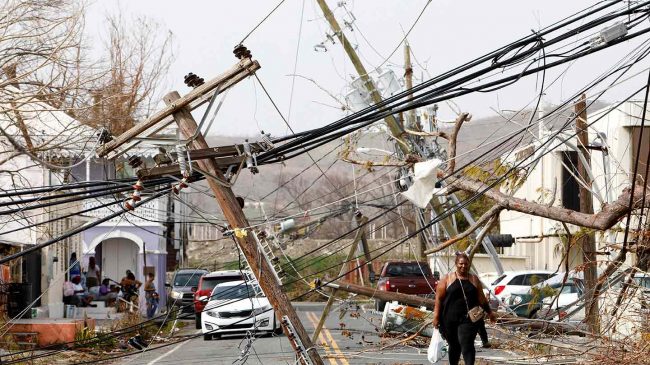Puerto Rico’s elected government and federally appointed oversight board often disagree, but they both support privatizing the island’s bankrupt electrical utility. Unfortunately, an agreement among elected and appointed officials cannot guarantee privatization: a non-governmental entity will need to acquire and operate the Puerto Rico Electric Power Authority (PREPA). So far, unfortunately, Puerto Rico has failed to lay out terms that would make sense to any potential acquirer.
This is not to say that privatization is a bad idea; indeed, it is the only viable alternative. Despite issuing billions of dollars of bonds ostensibly to support its capital program, PREPA has failed to adequately develop and maintain its energy infrastructure. As a result, its generating facilities are antiquated, and its power grid is unable to withstand powerful hurricanes. Further, despite charging high kilowatt-per-hour rates relative to mainland-based utilities, PREPA is not only losing money—it has been unable to produce audited financial statements for the last three fiscal years.
Although progressives like to criticize “greedy” privately-owned utilities, they would be seriously challenged to name a private electricity company performing as badly as PREPA. Since six-month long power outages are bad for the bottom line, shareholders of a private utility would undoubtedly force out managers that allowed them to happen, as utilities cannot charge for what customers can’t consume. Massive revenue losses don’t strike the same sense of urgency when confronted by state-run enterprises, which typically receive favorable tax treatment, accounting standards, and debt considerations upon which private actors cannot rely.
PREPA’s failures illustrate flaws inherent in the top-down, anticompetitive approach used in establishing and operating many New Deal-era agencies. After creating the publicly owned Tennessee Valley Authority, Franklin Roosevelt appointed New Dealer Rexford Tugwell as Puerto Rico’s governor, who, in the early 1940s, reprised the TVA model for the island Commonwealth. The Puerto Rico Water Resources Authority (which became PREPA in 1979) issued bonds to buy out the remaining private electric utilities on the island. This action not only established a government monopoly electric supplier, it also allowed the Commonwealth government to circumvent its constitutional balanced budget requirement, by borrowing money through a public corporation operating outside the budgetary process.
When a government runs a corporation with monopoly power and less-than-transparent finances, one can expect losses and rent-seeking, and PREPA is certainly no exception. Government-owned corporations have frequented the municipal bond market for decades, running up tens of billions in debt, with PREPA’s share exceeding $9 billion as it continues to work through bankruptcy proceedings initiated last year.
If debt were the only issue, PREPA’s future would be difficult enough, but poor management and corrupt practices have long created problems of their own. Bribes to officials have plagued PREPA for decades, with the recovery from Hurricane Maria inviting even more allegations of corruption—from highly questionable contracting practices to the hoarding of recovery supplies and prioritization of bringing power back to PREPA officials and favored individuals following Hurricane Maria at the expense of more “public” infrastructure, such as the Luis Muñoz Marín International Airport—in addition to more bribes.
Only by installing management that succeeds or fails based on its ability to serve customers can power generation and distribution on Puerto Rico become free of the poor incentives that have driven its poor operations for decades. After decades of corruption, debt, and mismanagement from government control, an outside entity taking over in an agreement that avoids the poor incentive structure of a government-run monopoly seems, at minimum, the only way to avoid repeating PREPA’s past mistakes.
So, it is not a question of whether PREPA should be privatized, but how to do so. And what we have seen thus far from the Puerto Rico government and fiscal control board falls far short of privatization best practices. The correct approach would be for the government to outline a market structure and rate regime under which a private owner could expect to make a reasonable return on equity, and then solicit expressions of interest.
But Puerto Rico’s authorities have not done this homework. The PREPA fiscal plan offers some aspirations but does not provide a realistic way forward for a private operator. Indeed, it contains several red flags that can be expected to scare away most any potential investor. For example, the fiscal plan shows consumption dropping considerably for the next few years, to 13 gigawatts in Fiscal Year 2023 from 17 Gigawatts in Fiscal 2017 (which ended on June 30, before Irma and Maria hit) and 21 Gigawatts recorded in Fiscal Year 2007.
Reduced energy use in Puerto Rico is due largely to the island’s chronic population decline. While we know that outmigration accelerated in the immediate aftermath of Hurricane Maria, it remains to be seen whether the exodus will continue at an elevated rate or whether it will return to pre-storm levels. Exacerbating the uncertainty over future electricity demand are doubts over PREPA’s forecasting methodology. As one outside expert concluded: “PREPA’s support for its load forecasting is severely lacking, including the methodological description, theoretical underpinnings, and provision of source data and assumptions pertaining to its forecast.”
So while we know that PREPA’s acquirer will be looking at declining demand, there is much uncertainty over how fast the decline will occur. In addition to lower demand, the plan also calls for lower rates. While PREPA currently charges 24.5 cents per KwH on average, the plan sets a rate target of under 20 cents per kWh by 2023, with rates decreasing year over year.
Although the proposed rate cuts would bring PREPA more in line with rates charged in the continental US, that may not be the right benchmark. Because PREPA is situated on an island, it does not have access to the pipelines that inexpensively transport fuel to mainland utilities. If PREPA’s rates are instead compared to those charged by other island-based utilities, its rates seem less excessive. Indeed, energy costs in Hawaii exceed 30 cents per kwH for many users – well above Puerto Rico’s rates.
The fiscal plan argues that a private operator could make a profit at 20 cents per KwH by switching to renewable sources such as wind and solar. The document even includes an “aspirational generation plan” calling for the new owner to source 39% of its power from wind and solar in 2023, up from just 6% today. But does it make any sense to build new generation capacity – at an estimated capital cost of $2.9 billion – on an island where demand for electricity is dropping?
Finally, the Fiscal Plan does not make clear what will happen to PREPA’s existing $9 billion debt load. Would a private operator become responsible for this crushing debt load or does the government intend to sell PREPA’s assets while repudiating its bonds? If the latter, bondholder groups and municipal bond insurers (who covered some of PREPA’s obligations) will undoubtedly want their day in court.
When a private company files a Chapter 11 bankruptcy, it is common to convert the insolvent firm’s debt into equity. Existing shareholders lose their interest in the company and bondholders become the new shareholders, an approach that could prove the right answer for PREPA. Since the Puerto Rico government has yet to formulate a plausible scenario under which a company could profitably take over and run PREPA, maybe it is time to simply turn the keys over to bondholders and let them figure out how to manage the utility in a cost-effective manner.
Alternatively, the government should settle with PREPA’s creditors—allowing them a partial recovery—before any privatization deal closes. PREPA’s generation and transmission infrastructure, as well as its management and operations could be bid out in a long-term concession agreement, which could include conditions calling for long-term capital investments in updating and improving energy infrastructure. That way a new operator could start with a clean balance sheet and clearly delineated operating conditions, including a reasonably-long time horizon from which to recover returns from capital investments in PREPA’s infrastructure.
Whether run by bondholders or a private partner selected through a competitive bidding process, Puerto Rico’s energy future will require extensive private sector support. Faced with outdated infrastructure, a declining population, and a continuing recovery from a devastating hurricane, leading Puerto Rico to a better energy future will undoubtedly be difficult. With the right combination of ingenuity and oversight, Puerto Rico could replace PREPA with an arrangement that more effectively serves the island’s citizens, who have repeatedly suffered at the hands of a monopoly public utility that repeatedly put the interests of its top officials ahead of its customers.


